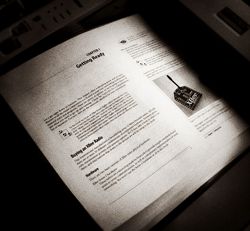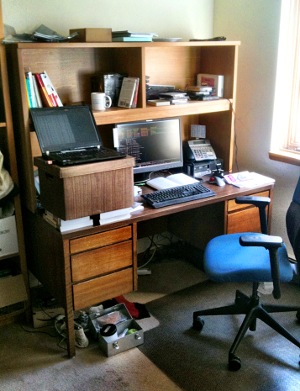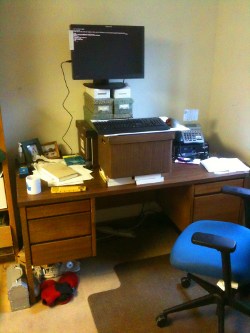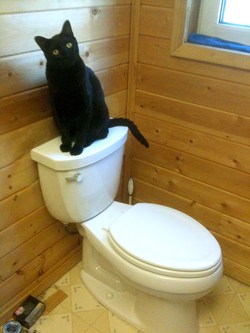Last Thursday afternoon, I set up a laptop on the side of my desk, at a height reasonably comfortable for working while standing (see the photo on the right). Over the past couple years I’ve seen several articles on the Internet advocating standind desks as a way to keep a person awake and alert throughout the day. Two weeks ago there was a story in the New York Times Magazine entitled Is Sitting a Lethal Activity?, and the Internets (and NPR on Monday) have been all over the story. The punchline from the Times Magazine story:
Sitting, it would seem, is an independent pathology. Being sedentary for nine hours a day at the office is bad for your health whether you go home and watch television afterward or hit the gym. It is bad whether you are morbidly obese or marathon-runner thin. “Excessive sitting,” Dr. Levine says, “is a lethal activity.”
Last Friday was my first full day at my temporary standing desk. I worked from 6:30 until around 12:30 primarily standing (I’d say around 80 - 90% of the time), and after that I started sitting around half the time because my feet and lower back started to hurt.
Day number two was similar to the first day: after about six hours on my feet, my heels and lower back started hurting. I continued standing until I’d been on my feet for a full eight hours and then spent an hour or so sitting. My neck, shoulders, and right wrist were a little tired at the end of the day, but I think all of this has more to do with using a laptop than standing. The screen is at arm level, so I’m looking down on it all day, and because it’s smaller than my normal monitor, I think there is a bit more hunching to get close. I don’t have my usual trackball either, which probably contributes to the wrist discomfort.
The third day (Tuesday) was rough. I stood the entire day, and migrated off the laptop setup to using my regular computer (v0.2). I also rode my bicycle to work, so my legs were already tired. I made it through the first four hours without any issues, but my back started hurting about then, and by the end of the day the heels of my feet were really killing me. Part of the issue may be that I was in my slippers, and standing on the anti-static mat rather than the carpet because of the new setup. Hopefully shoes with some padding, and possibly an anti-fatigue mat will lessen the pain on my feet.
On day four I wore running shoes and removed the anti-static mat so I was standing directly on the carpet (over concrete). Both of these things helped, but again, between four and six hours into the day, my lower back started to hurt, as did the heels of my feet. But it really didn’t seem as bad as Tuesday, so I may be getting used to it. The new setup with the monitor at an appropriate height, plus a real keyboard and trackball also helps.
Thursday I woke up with a stiff neck and rode my bike to work, so I expected that standing all day would be pretty brutal, but it really is getting easier. The heels of my feet are still a little tired for the last couple hours of work, and my lower back hasn’t quite gotten used to the additional load, but it’s not affecting my concentration like it was in the beginning and I’m starting to be pretty comfortable working at the computer in this position.
Update: It’s now been a couple weeks since I started this experiment. The heels of my feet still hurt a little after a full day of work, and I occasionally experience some lower back pain during the day, but I can feel the benefits already. I’m less tired outside of work, I feel like I’m more productive at work because I am always moving around, and I don’t doubt that the setup will provide long term health benefits over sitting at work and at home for most of my waking hours. The other thing I’ve noticed is that my posture is much better in a standing position and that’s helping to relieve some of the neck stiffness I’d been living with for the past several years. It seems much easier to keep good posture while standing, than having to think about sitting up while in a chair.
All that’s really left to do is make the setup more permanent by building something to set things at the right height and getting an anti-fatigue mat for the floor in front of my keyboard.

I recently purchased Building Wireless Sensor Networks in electronic form. O’Reilly offered it for download in several electronic formats, including ePub (for my iPhone) and PDF formats. After looking at the content, I decided I wanted to print out the first couple chapters to make it easier to work with the devices without having to continually fiddle around with my phone.
I used the following commands. psresize enlarges each page, in this case by 20%, and pstops is used to move the right-side page to the left by an inch. For the cover page, and other full-bleed content, this will cause the right-side page to overlap the left, but because of the margins around the text block throughout the majority of the book, this overlap doesn’t matter and it allows us to make the text bigger when it’s printed two pages per side.
$ pdftops Building_Wireless_Sensor_Networks.pdf
$ cat Building_Wireless_Sensor_Networks.ps \
| psresize -W8.5in -H11in -w10.20in -h13.20in \
| pstops "2:0(0,0),1(-72,0)" \
| psnup -2 > wireless_networks_nup.ps
$ ps2pdf wireless_networks_nup.ps
To print, choose double-sided, flip on short edge.
I’m trying out a standing desk at work and I discovered that when I went to my blog (and our internal wiki) that for some reason, Chrome on the laptop I’m using wasn’t displaying monospace fonts the way I expected. In Chrome’s preferences I could set the font size for all the other fonts, but it only let me choose the monospace font, not it’s default size. I’d never noticed this before.
A quick Internet search revealed this very helpful page: http://meyerweb.com/eric/thoughts/2010/02/12/fixed-monospace-sizing/
It turns out that monospace sizing is a common problem, and even worse, how they’re sized is browser dependent. The hack is to define the tt, pre, and code elements in your CSS as follows:
1 2 3 4 | pre, tt, code { font-family: monospace, sans-serif; font-size: 1em; } |
It seems wrong to have monospace and then sans-serif, but including sans-serif (or any other font-family category besides monospace) causes browsers to respect the following font-size declaration. Without it, the browser assumes that the 1em sizing is relative to the default monospace font size (which is too large and unchangable) rather than relative to the size of the rest of the content on the page.
Anyway, it works. For now.
Update: Actually, it doesn't work. Firefox, Safari and Chrome on a Mac let you choose the monospace font size, and tweak it until it matches the body text size. When this hack is applied, the monospace fonts become the same size as the body font, which is typically too large.
In late August 2005, Hurricane Katrina struck New Orleans, destroying the levees designed to protect the city, flooding 80% of it, and killing 1,464 people. City of Refuge, written by the author of Why New Orleans Matters and a resident of the city, is a fictional retelling of the disaster and it’s aftermath. It’s an emotional story, well written, and does a good job of making New Orleans and the devastation of Katrina real. Read next to Dave Egger’s Zeitoun, it’s hard to imagine how the maintenance of the levees, emergency response, and relief efforts could have been worse. Thankfully, book mostly stays clear from making political arguments or assigning blame, focusing mainly on how two different families cope with the destruction of the city they lived in.
I enjoyed it—learning more about the disaster and the rhythms and flavor of the city itself—but I wouldn’t recommend it except for readers interested in another perspective on Katrina.
A month ago, we noticed that our pump was coming on when we weren’t using any water. We immediately suspected the toilet because there was no evidence of water anywhere (on the floor, leaking under the house, etc.), but when we shut off the water supply to the toilet before going to bed, the tank was still full of water in the morning. The gaskets in our kitchen faucet were starting to fail, and it was occasionally leaking down the stem of the faucet, so we replaced the cartridge hoping this would solve our water problem. The faucet works a lot better, but we were still losing water.
We tried turning off the pump at night to confirm we really were losing water, and when we got up in the morning, we had no pressure. The combination of turning off the pump and the toilet supply resulted in no loss in pressure, so the leak was somewhere in the toilet after all. It wasn’t the flapper valve (or the tank would be empty in the morning), and we didn’t see any drips or leaks, so the supply must have been leaking into the top tank somewhere under the water and draining into the bowl where we didn’t notice it.
The obvious fix for this is to replace the stuff in the tank. But the toilet didn’t really work very well anyway, and used the full 1.6 gallons per flush. Andrea installed a dual flush kit that was supposed to use less water for liquid waste, but it didn’t work: the lower “number one” button didn’t release enough water into the bowl for it to actually flush. 1.6 gallons of water doesn’t sound like much, but we’re currently paying 10 cents a gallon for water, so we’re spending more than a dollar a day just to flush the toilet. We have an outhouse, but because we’re so close to Goldstream Creek, it can’t be in the ground and needs to be pumped out whenever it gets full. So our best option was to replace the leaking toilet with something that won’t leak, and uses less than the standard 1.6 gallons of water per flush.
The two current strategies to lowering water consumption in a toilet are to make the top tank smaller so less water is used for every flush, or to implement a dual flush setup where a small amount of water is used for liquids and the full volume flushes solids. Consumer Reports doesn’t give the dual flush models very high ratings, mostly because the bowl isn’t rinsed as well when so little water is used. As a result, we decided to get a toilet that uses a smaller top tank (1.28 gallons per flush). The highest rated model by Consumer Reports is an American Standard one-piece “Cadet 3,” but the local plumbing place and the box stores didn’t have that model in stock. Getting one shipped to Alaska would have taken more than two months. The next place models were the two-piece version of the Cadet 3 and the Kohler Cimarron. Consumer Reports gave the Cimarron slightly higher marks overall, with better bowl cleaning but worse solid waste elimination ratings. While we were in the store, we went to the web site for the company that rates toilets for solid waste elimination (www.map-testing.com) and consulted the latest ratings (from April 4th (!)). The Cimarron was better rated for this statistic (1,000 vs. 800), so that’s what we got.
Installation went smoothly. Thus far, we’re satisfied. What is surprising about the toilet is how fast it flushes. It empties the top tank into the bowl in less than a second, and the bowl empties almost immediately after that. It seems that the strategy is to dump almost all of the top tank water into the bowl as quickly as possible to eliminate waste, and use the small amount remaining to wash down the bowl. So far so good! We’re saving more than three cents each time we flush, and hopefully we will have many fewer double (and more…) flush events.



